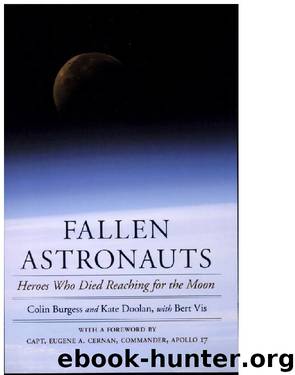Fallen astronauts by Colin Burgess

Author:Colin Burgess
Language: eng
Format: epub
Publisher: University of Nebraska Press
Following his decision to join the air force as his career field, and after a two-month graduation leave, White went to Bartow Air Force Base in Florida to begin flight training.
The early fifties were a time of rapid buildup of the armed forces following the onset of the Cold War as well as the hot war in Korea, where a lot of White's West Point army friends ended up. Usaf pilot training accelerated rapidly to a level reminiscent of World War II. A dozen or so civilian flying schools sprang up across the southern United States to supplement the small on-base Usaf capacity for beginning pilot training. The instructors were all civilians—World War II veterans—with a small cadre of Usaf personnel at each school to monitor standardization and serve as check pilots. Most of the airfields were old World War II bases that had been given up by the Usaf after the war ended, and many found commercial use beyond just aviation.
At this time flying training programs followed a format radically different from that of earlier years. During World War II, flying students fresh from the streets or farms began with simple, rather slow, fixed landing gear Primary Trainer (pt) aircraft. Those who succeeded then moved on to the Advanced Training (at) aircraft, which was the AT-6, a much faster and more sophisticated airplane with retractable landing gear. Graduates were then awarded wings and went on to check-out courses in one of the fighters of the time, such as the p-47, p-51, and P-4O, followed by assignment to a fighter squadron.
Sometime after the war, a high-level decision was made to simply skip the primary phase and have new students begin immediately with the AT-6, the previous advanced trainer. With that, the "A" was dropped from the AT-6 designation. This was the flight-training program Ed White and Hank West entered in the summer of 1952 along with 120 of their West Point classmates. An equal or larger number of graduates from Annapolis was in the same course. The Air Force Academy did not exist at the time, so about a quarter of the graduates of West Point and Annapolis were permitted to select the Usaf as their service of choice.
This phase of training took six months. In February 1953, White married Pat Finegan at Bartow Afb. The next step, advanced training and the awarding of pilot's wings, took place at a Usaf Training Command Bases, where students were instructed in either jet training leading to fighter specialization, or in multi-engine courses leading to bomber/transport career paths. White was sent to James Connally Afb in Texas for jet training.
Download
This site does not store any files on its server. We only index and link to content provided by other sites. Please contact the content providers to delete copyright contents if any and email us, we'll remove relevant links or contents immediately.
Tools of Titans by Timothy Ferriss(8306)
Turbulence by E. J. Noyes(7981)
Secrets of Antigravity Propulsion: Tesla, UFOs, and Classified Aerospace Technology by Ph.D. Paul A. Laviolette(5335)
Astrophysics for People in a Hurry by Neil DeGrasse Tyson(5152)
Room 212 by Kate Stewart(5073)
Design of Trajectory Optimization Approach for Space Maneuver Vehicle Skip Entry Problems by Runqi Chai & Al Savvaris & Antonios Tsourdos & Senchun Chai(5039)
Pale Blue Dot by Carl Sagan(4960)
The David Icke Guide to the Global Conspiracy (and how to end it) by David Icke(4658)
A Journey Through Divination and Astronomy by Publishing Pottermore(4364)
Goodbye Paradise(3763)
Apollo 8 by Jeffrey Kluger(3671)
COSMOS by Carl Sagan(3590)
The Five People You Meet in Heaven by Mitch Albom(3521)
Losing the Nobel Prize by Brian Keating(3519)
How to Read Water: Clues and Patterns from Puddles to the Sea (Natural Navigation) by Tristan Gooley(3434)
Brief Answers to the Big Questions by Stephen Hawking(3394)
How to Read Nature by Tristan Gooley(3294)
The Order of Time by Carlo Rovelli(3163)
A Brief History of Time by Stephen Hawking(2994)
